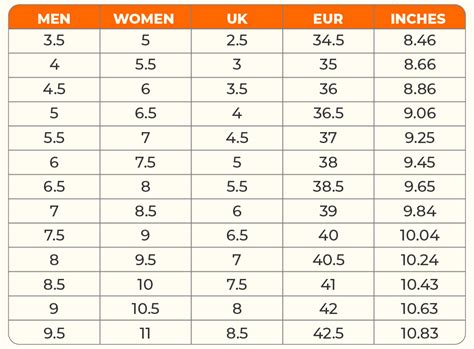Mens Size To Womens Size Converter

Converting men’s sizes to women’s sizes can be a bit tricky, as sizing standards vary between brands and styles. However, we can provide a general guideline to help you navigate this conversion. Please note that these conversions are approximate and may not be exact, as body types and fit preferences can differ greatly between individuals.
Shoe Size Conversion
When it comes to shoe sizes, the conversion between men’s and women’s sizes is relatively straightforward, with a general difference of 1.5 to 2 sizes. Here’s a rough guide:
- Men’s Size 6 corresponds to Women’s Size 7.5 to 8
- Men’s Size 7 corresponds to Women’s Size 8.5 to 9
- Men’s Size 8 corresponds to Women’s Size 9.5 to 10
- Men’s Size 9 corresponds to Women’s Size 10.5 to 11
- Men’s Size 10 corresponds to Women’s Size 11.5 to 12
This pattern continues up the size scale. However, it’s crucial to remember that shoe size conversions can vary significantly between different shoe brands and styles due to differences in design, materials, and intended fit.
Clothing Size Conversion
Clothing size conversions are more complex due to the variety of clothing types and the differences in measurement standards around the world. For general purposes, here’s a simplified conversion guide for tops and bottoms:
Tops:
- Men’s Small often corresponds to Women’s XS or S
- Men’s Medium often corresponds to Women’s M
- Men’s Large often corresponds to Women’s L
- Men’s X-Large often corresponds to Women’s XL
Bottoms:
- Men’s 30 Waist can be similar to Women’s 25-26 Waist
- Men’s 32 Waist can be similar to Women’s 27-28 Waist
- Men’s 34 Waist can be similar to Women’s 29-30 Waist
Keep in mind that these conversions are very approximate and can vary significantly based on the brand, style, and fabric of the clothing.
Accessory Size Conversion
For accessories like hats, belts, and watches, the sizing can be less about gender and more about personal preference and specific measurements. However, some general guidelines can be applied:
- Hats: Unisex sizing is common, but men’s hats tend to be slightly larger. If you’re converting, you might go down a size from men’s to women’s.
- Belts: Waist size is what matters here. Use the actual waist measurement for the best fit, regardless of the gendered size label.
- Watches: Watch sizes are often measured in millimeters and can be unisex. The choice usually depends on wrist size and personal style.
Conclusion
While these guidelines can help with converting men’s sizes to women’s sizes, the best approach is always to check the specific sizing charts provided by the manufacturer or brand. Each brand may have its unique sizing standard, and what works for one brand may not work for another. Additionally, consider factors like the material, intended use, and desired fit when choosing sizes. If possible, trying on items or reading reviews from other customers can provide valuable insights into the best size for your needs.

